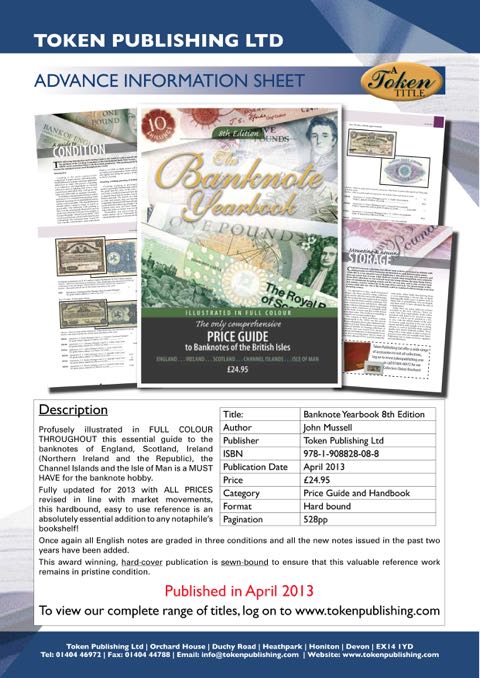Book
Compare the catalogs: TBB vs SCWPM
08 04, 2019 21:55


The 25th edition of Krause’s Standard Catalog of World Paper Money is now available, with only 88 new type listings, 20 of which aren’t illustrated, and none are in color.
Download this free document containing full listings from The Banknote Book for the new type notes added to the 25th edition of the SCWPM so that you can compare and contrast the two catalogs for yourself.
If you prefer the SCWPM, please support this site by buying the SCWPM 25th edition using this link.
If you want to increase your enjoyment and understanding of your hobby, subscribe to The Banknote Book.
Geldscheine-Online launches German-language banknote newsletter
17 07, 2018 10:15

On 5 July 2018, a new German-language online magazine for paper money collectors was launched called Geldsheine, containing current news about banknotes from all over the world, as well as articles about historical banknotes, notgeld, camp money, literature, and much more.
Compare the catalogs: TBB vs SCWPM
07 04, 2018 12:41

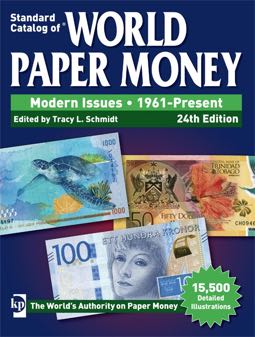
The 24th edition of Krause’s Standard Catalog of World Paper Money is now available, with only 100 new type listings, many of which aren’t illustrated, and none are in color.
Download this free document containing full listings from The Banknote Book for the new type notes added to the 24th edition of the SCWPM so that you can compare and contrast the two catalogs for yourself.
If you prefer the SCWPM, please support this site by buying the SCWPM 24th edition using this link.
If you want to increase your enjoyment and understanding of your hobby, subscribe to The Banknote Book.
Press release: The Banknote Register 2nd edition
24 10, 2016 08:30
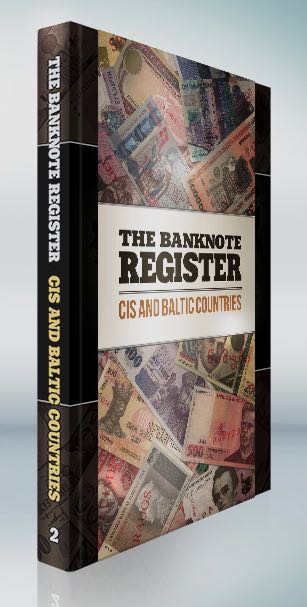
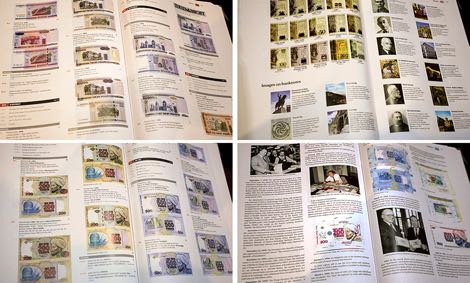
The Banknote Register: CIS and Baltic Countries
1991-2016, General Issues
Second edition (English)
Author: Dmitry Zagorenko (IBNS #11608, General Secretary of the Russian Chapter of IBNS).
Editor: Dmitry Litvak (IBNS LM #204, President of the Russian Chapter of IBNS).
Format: A4. Weight: 1,5 Kg.
Hard cover with pressed gilding and book jacket band.
344 full-color pages (paper 115 g/m2).
16 Chapters (Russia, Ukraine, Belarus, Uzbekistan, Kazakhstan, Georgia, Azerbaijan, Lithuania, Moldova, Transnistria, Latvia, Kyrgyzstan, Tajikistan, Armenia, Turkmenistan, Estonia).
Edition: 1000 pieces.
The Banknote Register provides the most detailed information on all emissions of paper money in post-Soviet countries from 1991 to present. It describes the history of money circulation establishment and development in the new sovereign states. The book gives detailed information on each banknote, variations and types, commemorative and souvenir issues, security features, designers, signatories, serial prefixes, images portrayed on the notes. It will be no exaggeration to say that the author with the help of collectors and staff of national banks has compiled the best known up to now data, many of which will be published for the first time, and also data unknown to many collectors. This work has resulted in compilation and classification of the most complete information on currency circulation in the post-Soviet countries.
The publication of the Register will, for sure, reduce the number of blank spaces in the history of circulation in CIS and Baltic states. Nevertheless, the author continues searching for materials and communicating with paper money collectors, museum workers, designers and bank specialists and laymen. We hope that the Register of Banknotes of CIS and Baltic Countries will encourage you as well to study actively the currency circulation in the post-Soviet countries.
Promo-video: https://youtu.be/O33FxdonxS0
Official website: http://banknote-register.com
For a $7 discount off the list price of $62, use the coupon code "BanknoteBook" when ordering the book by email. Registered shipment to any country in the world is $22, so the total discounted cost is only US$77.
Press release: United States Paper Money Errors
10 11, 2015 17:38
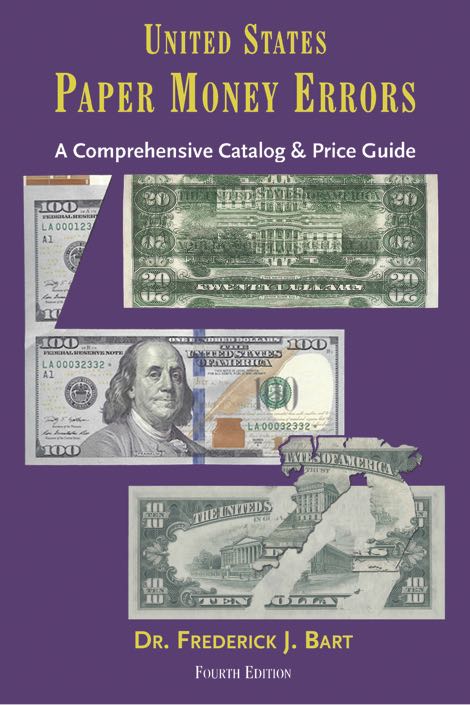
United States Paper Money Errors
Frederick J. Bart, 296 pages, soft cover, 146 x 228 mm, color illustrations, English, ISBN 978-0-87184-250-3, $27.95 (plus $5.75 shipping), Coin & Currency Institute, P.O. Box 399, Williston, Vermont 05495, http:www.coin-currency.com
New edition of comprehensive catalog and price guide makes first appearance since 2008
After a lapse of seven years, a new, fourth edition of United States Paper Money Errors, Fred Bart's ground-breaking book is now available. The 4th edition is more than just an update to the third recent – Bureau of Engraving and Printing (BEP) errors have been added, nearly all the illustrations have been changed, there is a rarity guide for each note, which additionally are now priced in four grades (EF, AU, Choice CU and Gem CU), and for the first time, there is a section showing some notes in color.
This has always been an enormously popular book, not only among established collectors, but also with newcomers seeking to learn more about their "find." There is no other book like it on the market. More than a price guide, its 296 5.75 x 9 inch pages contain a wealth of information on what to look for, as well as the mistakes to avoid. It is a necessity for all dealers, collectors, and anyone who comes into regular contact with paper money.
Error notes continue to carve an ever larger niche in paper money collecting. This edition of the definitive reference allows advanced collectors to recognize the value in their holdings and still permits members of the general public to identify potentially profitable notes encountered in circulation. The book offers more than 550 photos, making identification easy. Chapters are arranged according to the actual production sequence within the BEP providing a logical flow to the arrangement. The book begins with an overview of paper money production and a discussion of error collecting. The next section deals with first and second printing errors such as board breaks, double denominations, inverted backs, and missing and offset printings. The next section details the types of overprint errors including misaligned and missing overprints, mismatched serial numbers, and stuck digits. The last section is devoted to folds and other errors. In addition, historic photographs from the BEP offer a fascinating glimpse into currency production during a bygone era, contrasting sharply with the advanced technology in use today.
The print version of the book, ISBN 978-0-87184-250-3, has a list price of $27.95 and is available from dealers and wherever numismatic books are sold. It may also be ordered direct from the publisher, Coin & Currency Institute, P.O. Box 399, Williston, Vermont 05495 or online at www.coin-currency.com. $5.75 should be added to each order for shipping and handling. Major credit cards are accepted. Call toll-free 1-800-421-1866. Fax (802) 536-4787. E-mail: mail@coin-currency.com.
An E-book edition, ISBN 978-0-87184-005-9, is available for digital download or on USB stick at www.coin-currency.com, or for viewing on tablet-like devices, from the Amazon Kindle store. List price is $17.50
Preview pages are available for viewing at www.coin-currency.com.
COIN & CURRENCY INSTITUTE
P.O. Box 399, Williston, Vermont 05495
Tel. (802) 878-0822 • Fax (802) 536-4787
E-mail: mail@coin-currency.com
Contact: A.L. Friedberg
Isle of Man Paper Money
26 05, 2015 10:39
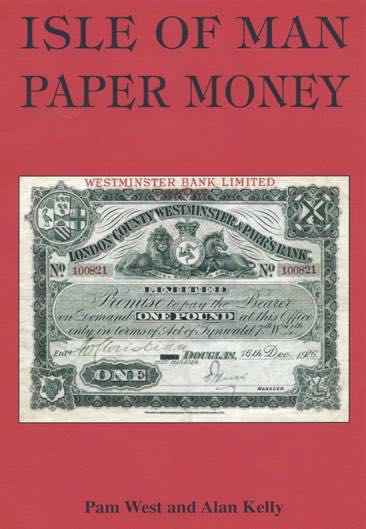
Isle of Man Paper Money
Pam West and Alan Kelly, 420 pages, soft cover, 147 x 210 mm, color illustrations, English, ISBN 9780954345747, €24 (plus shipping), Pam West, British Notes, PO Box 257, Sutton, Surrey SM3 9WW. Tel: 0208 641 3224, www.britishnotes.co.uk, pam@britishnotes.co.uk
Reviewed by Jonathan Callaway (full disclosure: a contributor to this catalog)
You do not have to be a collector of Isle of Man notes to recognise the contribution this book makes to our understanding of the notes issued on this small island in the Irish Sea, part of the British Isles geographically but not part of the United Kingdom politically.
Pam West and Alan Kelly have reviewed and catalogued every example of paper money ever issued on the Isle of Man. There have been earlier catalogues but none is as comprehensive in its coverage and this is the first one to provide a complete pricing guide.
The book opens with an extensive introduction chapter contributed by Jonathan Callaway covering not only the historical background but also a brief outline of the currency history of the Island. The first section of the catalogue proper covers the many early 19th century card money issues which were abolished in 1817. Many new discoveries have been listed and many new images of these rare pieces are included. The authors have trawled not only institutional collections on the Island and elsewhere but also gained access to the leading private collections.
The next section deals with the first banknotes proper on the Island, starting in 1788 and covering the early issues ahead of an Act of the Tynwald (i.e. the Isle of Man’s own parliament) in 1817 which set out the Isle of Man’s first regulations for banknote issuance. The ensuing chapter covers firstly the various private banks licensed to issue notes under the 1817 Act. Once again many previously unknown notes have been found and illustrated. The chapter then goes on to cover the Isle of Man’s first joint stock banks. These better capitalised banks did eventually drive the private banks out of business but not without a few casualties of their own. There are potted histories of each one including the ill-fated Bank of Mona which abruptly ceased trading when its Scottish parent collapsed catastrophically in 1878. Each bank’s note issues are carefully set out with every signature variety described and illustrated. Proofs and essays are also listed and where possible illustrated.
The complex history of Dumbell’s Bank comes next, again with illustrations of a number of very rare notes and a fully detailed listing of the bank’s issues. This bank failed in 1900 and creditors got just 12s 7½d (63p) in the pound although the note holders were paid out in full – hence fully issued notes are rare today.
The final note issuing bank to be established on the Isle of Man was the Isle of Man Joint Stock Banking Company Limited, in November 1865. The bank’s issues are covered with the same degree of detail as previous issuers but there is more – when Waterlow & Sons Ltd took over the printing contract in 1927 they used the positional plate letters seen on all the notes they produced. Here the book sets out the plate letter sequences in remarkably full detail. A total of 530,000 £1 notes were printed by Waterlows with one master plate for each side of the note, each with four impressions on it. Each impression was given its own plate letter and the book lists in full the complex pattern of plate letters, prefixes and dates. The original master plates were re-engraved in 1952 and each of the four impressions given a new plate letter. On top of this there were frequent signature changes and again these are set out in complete detail. For specialist collectors this is as good as it gets! Waterlow also printed 7,200 £5 notes for the bank between 1927 and 1960. Such a tiny print run required just one plate for each side but there are still five date and signature varieties to collect despite the fact that 2,600 of these notes were never issued.
In 1896 saw the first of the English banks arrive to offer the local banks serious competition. Four English banks eventually issued their own notes. These issues are popular with many collectors due to the fact that they are the only banknotes any of these banks ever issued; they were unable to issue notes in England itself due to a different legislative environment and the dominance of the Bank of England. Once again the book does not let collectors down and provides every level of detail on type, variety and signature changes through to 1961 when the Tynwald withdrew the right for commercial banks to issue their own notes.
The book next devotes a long chapter to the Internment Camp issues from both World Wars. As a small island located midway between Britain and Ireland, the Isle of Man was deemed to be an ideal location to intern ‘enemy aliens’ during both global conflicts. These were civilians originally from the countries the United Kingdom found itself at war with. Many of the camps issued their own ‘currency’ in the form of vouchers and canteen tickets. The many issues are covered here in unparalleled detail with many issues recorded and illustrated for the first time. A wealth of new information is offered and much fascinating background is provided on the camps themselves.
The final third of the book focuses on the issues of the Isle of Man Government – a much loved and widely collected series which has been running for over 50 years and still going strong. All these beautiful notes carry a portrait of H.M. Queen Elizabeth II and the many varieties and signature changes are naturally covered in the full detail we have come to expect. Nearly every known proof, specimen and colour trial is illustrated and once again a lot of new information has been unearthed for collectors to enjoy.
‘Isle of Man Paper Money’ covers well over 200 years of paper money history in its 412 pages. It achieves a level of detail few catalogues can aspire to and will stand for many years as the definitive guide to the Isle of Man’s paper currency issues. The book is beautifully produced and all illustrations are in full colour. This reviewer cannot recommend this book enough. It would grace the shelf of any paper money enthusiast and surely whet the appetite of anyone who has yet to start collecting these fascinating and lovely notes.
Book Review: Catalogue of Greek Paper Money 1822-2002
12 03, 2015 16:50

Catalogue of Greek Paper Money 1822-2002
Evangelos Fysikas, 400 pages, soft cover, 230 x 150 mm, B&W illustrations, Greek/English, ISBN-13 9789609363327, €34 (plus shipping), http://greeknotes.blogspot.gr, greeknotes@gmail.com
Reviewed by Owen W. Linzmayer
Kudos to author Evangelos Fysikas for having created a wonderfully accessible and detailed specialized catalog covering Greek notes issued by various banks from 1822 until the 2002 introduction of the euro.
The chapters are broken up by issuer, with the notes presented chronologically, and then by denomination. While the descriptions of the notes’ imagery and designs are very bare bones, the listings do contain details of importance to specialized collectors and generalists alike, including printer, dimensions, introduction/withdrawal dates, and watermarks. Instead of prices, the catalog shows rarity ratings (1-9) for four grades of condition (F, VF, XF, UNC). This is sure to disappoint collectors hoping for guidance with valuations, but by eliminating prices, the catalog won’t appear obsolete if the market changes drastically, which is not out of the question given Greece’s recent economic troubles.
Each chapter begins with a fair amount of introductory text in Greek followed by English translations which are remarkably clear and unambiguous. I appreciate the historical background contained in these sections, helping explain why notes were issued as well as describing the differences between the many issues.
My biggest disappointment with this catalog is the use of black and white illustrations which simply don’t do justice to the beautiful color notes. Also, a fair number of the earlier, rarer notes are not illustrated at all. Another disappointment is a lack of Pick numbers in the main listings. Fortunately there is a cross-reference table in an appendix, but that’s not nearly as convenient.
For any serious specialized collector, Catalogue of Greek Paper Money is a must-have reference, if for nothing other than the appendices which succinctly list every note variety by date, prefix and serial number ranges, and signatures.
Viet-Nam Coins & Papermoney catalog reprinted
11 03, 2015 10:10

Massimiliano Valota has reprinted the second edition of Viet-Nam Coins & Papermoney, a 350-page catalog in English with color images, index of rarity, and cross-references to other catalogs for easy searching. The catalog covers the coins and notes of South Vietnam, North Vietnam, Vietnam Socialist, and military payment coupons.
This catalog received an Honorable Mention in 2013 by the International Bank Note Society "for significant contribution to the advancement of numismatic knowledge."
Cost is 30 euro each, excluding shipping.
Anyone interested in buying one of these catalogs can contact the author by clicking the link below.
Courtesy of Massimiliano Valota (www.vietnampapermoneyandcoins.com).
The Numismatourist: The Only Worldwide Travel Guide to Museums, Mints, and Other Place of Interest for the Numismatist
27 07, 2014 21:10
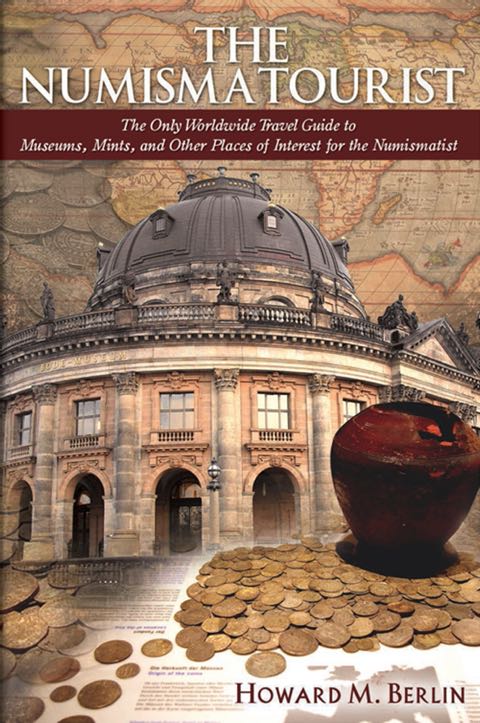
The Numismatourist: The Only Worldwide Travel Guide to Museums, Mints, and Other Place of Interest for the Numismatist
Howard M. Berlin, 414 pages, soft cover, 6 x 9 inches, color illustrations, English, ISBN-13 978-1933990293, $29.95, (Order from Amazon.com)
The Numismatourist is the first book of its kind as a world-wide travel guide for the numismatist. It is also for the numismatist who is traveling, either on vacation or business, and wishes to visit those places that of are interest to the hobby or profession. Inside you will find a numismatic travel guide, listing over 175 places in 75 countries open to the public, with almost 100 of these described in detail with pictures that are spread over North, Central, and South America, the Caribbean, Europe, Asia, the Middle East, Africa, and Oceania-Pacific. The foreword is written by Karen M. Lee, Curator, National Numismatic Collection, National Museum of American History at the Smithsonian Institution.
Polymer Bank Notes of the World
23 07, 2014 14:05
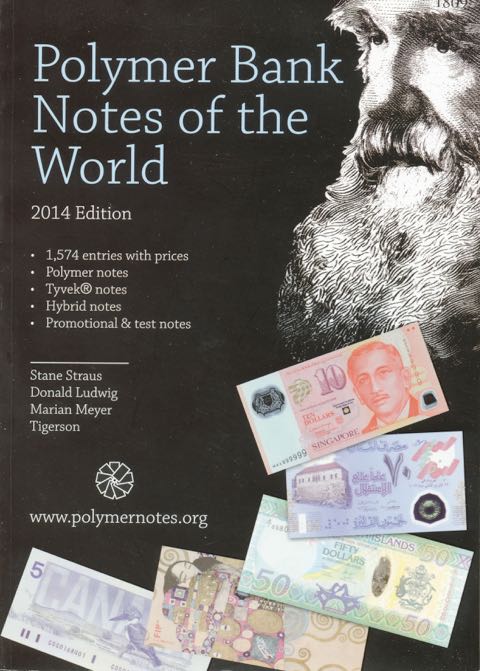
Polymer Bank Notes of the World
Stane Straus, Donald Ludwig, Marian Meyer, and Tigerson, 144 pages, soft cover, 297 x 212 mm, color illustrations, English, ISBN 9789619365908, €20 (plus shipping), kin2.orders@gmail.com
Reviewed by Owen W. Linzmayer
Polymer Bank Notes of the World is the definitive guide to one of the hottest numismatic fields: non-paper notes, be they Tyvek, polymer, or hybrid (combinations of paper and polymer). The new 2014 edition uses larger format pages than the preceding 2012 edition, and has expanded from 122 pages to 144 pages, with coverage of an additional 285 entries of both issued and promotional/test notes (created by security printing firms to show off their prowess and new anti-counterfeiting features).
Each note is illustrated in color, front and back. Below the illustrations are descriptions with some historical background about the vignettes on the notes, as well as detailed variety listings, each assigned their own unique Straus number (for example: Australia S1R3a), along with cross-references to Pick and The Banknote Book catalog numbers. Pricing in euros is given for uncirculated notes, and lesser grades in the few cases where pristine notes aren't readily available.
The lines devoted to describing the variations are somewhat dense and deciphering the frequent abbreviations requires a bit of mental gymnastics, but as a fellow cataloger with an interest in collecting these notes, I appreciate the authors' attention to details, accuracy, and specificity. Also well received are all the footnotes below the variety listings which provide additional information about the notes, helping put them into context and enhancing their appeal.
If you're one of the many people with a penchant for polymer, this catalog belongs in your reference library (it's a bargain at only 20 euros), and the accompanying web site (http://www.polymernotes.org) should be a frequent stop as you browse the web for the latest information.
Press release: 2nd edition of Encyclopedia of Sudan Banknotes 1856 - 2012
09 06, 2014 10:37
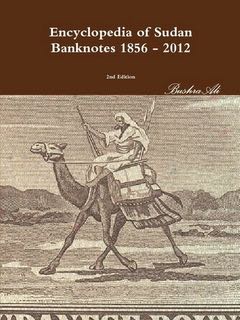
Bushra Ali, a frequent contributor to this site and The Banknote Book, recently published the second edition of his Encyclopedia of Sudan Banknotes 1856 - 2012. This specialized catalog is available via Lulu.com as a print-on-demand book or an eBook. This 512-page second edition covers all notes from 1856 to 2012, and includes Egyptian notes used in Sudan, along with many notes unlisted in the SCWPM, such as unadopted designs, specimens, and proofs. Visit Lulu.com and click on the Preview link below the image of the book cover to see sample pages of this detailed catalog.
New in the second edition:
- section for un-Adopted Color Trial for Egypt Notes used in Sudan in Chapter 2
- Archives Specimen under Pricelist and re-edit some price under pricelist in Chapter 3
- more un-adopted Design for Sudan and Egypt notes used in Sudan in Chapter 2
- more information for some early Egypt notes in Chapter 1
- increase more than 65 pages from previous edition
Free samples of Banknotes of the World industry newsletter
15 04, 2014 10:15

InterCrim Press (Moscow, Russia) publishes books and magazines of interest to banknote collectors, most notably Banknotes of the World, a 40-page monthly newsletter containing news and articles covering the currency industry and the banking community in Russia and abroad. While the editorial is geared towards currency industry insiders, collectors may also appreciate learning about the business side of banknote production and handling. Each issue devotes several pages to the security features of new notes, and there are counterfeit notices as well, plus a fair bit of information on coins, too.
An annual subscription to Banknotes of the World costs $300 for 12 PDF issues, or $360 for printed copies. InterCrim Press has generously agreed to allow BanknoteNews to distribute three back issues as a free download to provide a sample of what you can expect when you subscribe to the newsletter.
Mehilba World Replacement specialized catalog now available
14 03, 2014 10:01
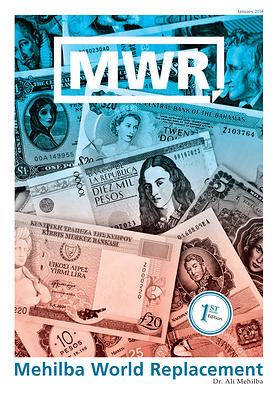
It's my great pleasure to announce the availability of fellow numismatic author Dr. Ali Mehilba's long-awaited catalog, Mehliba World Replacement. As most of you know, The Banknote Book explains how to identify replacement notes, but being an omnibus catalog it can't go into great detail nor provide values for same. Anyone who wants the most definitive examination of this fascinating aspect of numismatics in encouraged to purchase Dr. Ali's specialized catalog. At almost 600 color pages, it's well worth the list price of US$65. Apply coupon code owen (all lowercase) in the shopping cart to receive a $5 discount, and be sure to ask for a personalized autograph during checkout.
Book review: Coins and Banknotes of Yugoslavia, Slovenia, Croatia, Bosnia and Herzegovina, Serbia, Montenegro and Macedonia
13 07, 2013 09:26
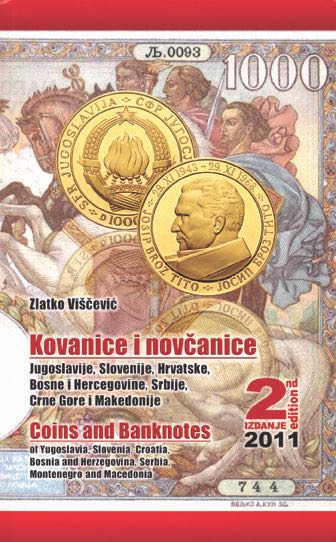
Coins and Banknotes of Yugoslavia, Slovenia, Croatia, Bosnia and Herzegovina, Serbia, Montenegro and Macedonia
Zlatko Viščević, 1173 pages, soft cover, 192 x 120 mm, black and white illustrations, Croatian and English, ISBN 978-953-56890-0-3, US$52 / €40 (free shipping), kin2.orders@gmail.com
Download the free sample chapter: Coins and Banknotes of the Kingdom of Yugoslavia.
Reviewed by Owen W. Linzmayer 7962
As author Zlatko Viščević mentions in the introduction to his impressive new catalog, collecting banknotes from the area of the former Yugoslavia can be quite challenging due to the large number of notes issued over the years. Compounding the problem is the Serbo-Croatian text on these notes and the complicated history of the region, both of which may be unfamiliar to many collectors. This new catalog doesn’t attempt to explain the tumultuous politics of the past three centuries, but is an invaluable addition to the reference library of anyone who specializes in collecting notes from this part of the world.
The first edition of this catalog was published in 2007. The second edition covers regular and commemorative notes issued in the intervening years, goes into greater depth in the descriptions, and now also includes special, fantasy, and private issues. In short, if you already own the first edition and like it, you’ll definitely want to buy the much-improved and expanded second edition.
Coins and Banknotes’ title spells out exactly what’s inside. The first half of the book is devoted to coins, the second half to notes, with chapters for the seven countries in each section. Within the chapters, the coins and notes are listed chronologically by denomination, which makes it easy to locate a particular piece and track changes over time, but at the expense of presenting complete families with common or complementary designs.
Each note type listing contains the denomination, catalog number, cross-references to Pick numbers and other specialized catalogs, reduced-size illustrations of the front and back, description of design elements and security features, and finally a list of varieties, with checkboxes for tracking your collection. Each variety is assigned a six-level rarity rating, and has values in euros for up to four levels of condition. Some notes also have auction results at the bottom of the page, though the values and results don’t always agree. Occasionally there are inset illustrations of details which determine varieties. These are useful in most cases, but sometimes the differences aren’t obvious due to the small size or lack of color in their reproduction.
Specialized collectors will appreciate the comprehensive lists of prefixes, as well as the inclusion of specimen and replacement notes in the variety tables, not to mention the assortment of “irregular issues” (color trials, partial proofs, etc.) and private/fantasy notes covered separately. While there isn’t much explanatory text regarding these issues, anyone interested in pursuing further research can consult the bibliography of source books and web sites at the end of each chapter.
The longer passages of prose in the catalog are presented in both Croatian and English, but the descriptions of the notes and their varieties are in Croatian only, which is a little frustrating if you care about such details and don’t want to rely upon Google Translate. Fortunately the English text everywhere else in the book is good enough that it’s easy to overlook the minor typos and understand the gist of the intended meaning.
One complaint I have about the catalog is its size. This is a bulky, compact tome measuring a whopping 55 millimeters thick, and heavy enough to break a toe if dropped on a foot. I would have preferred the coin and banknote sections split into two separate volumes, both printed in a larger format. As it is, the small black and white illustrations don’t do justice to the beauty of the notes, and the tiny text is hard to read if your eyesight isn’t perfect.
With this second edition, Zlatko Viščević has created a solid reference for collectors of notes of Yugoslavia and its constituent republics from 1849 to 2011. Coins and Banknotes delivers a dense helping of numismatic information at price that can’t be beat.
Press release: Encyclopedia of Sudan Banknotes 1856 - 2012
30 04, 2013 14:47

Bushra Ali, a frequent contributor to this site and The Banknote Book, recently published Encyclopedia of Sudan Banknotes 1856 - 2012. This specialized catalog is available via Lulu.com as a print-on-demand book. This 467-page first edition covers all notes from 1856 to 2012, and includes Egyptian notes used in Sudan, along with many notes unlisted in the SCWPM, such as unadopted designs, specimens, and proofs. Visit Lulu.com and click on the Preview link below the image of the book cover to see sample pages of this detailed catalog.
Press release: Banknotes of the World 2011-2012
25 04, 2013 08:48
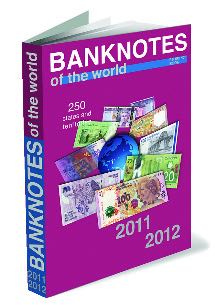
Reference book. Issue 10
In English and Russian.
30×21×3 cm
568 pages.
- Actualized and carefully checked information on cash circulation of all countries and territories of the world on the end of 2012;
- Regional geographic information for each state (location, chapter, currency, issuing bank, etc.);
- Peculiarities of cash circulation in the country;
- Currency notes of each state are grouped by categories: main circulation banknotes, banknotes, which are rare in circulation, but still maintain the status of legal tender; banknotes withdrawn from circulation: exchanged and cancelled;
- Rules and procedures for the exchange and cancellation of banknotes withdrawn from circulation;
- Description of security complex general circulation banknote series;
- Color images of front and back of general circulation banknotes with indication of security features.
Besides, you may find background information on monetary and economic unions, glossary of terms of security features and simple and convenient search system and cross-references.
Price: 200 USD or 150 EUR
The edition is intended for financiers, economists, bank personnel, traders, experts, geographers, historians, university professors and students as well as general public interested in history and economy of the world countries.
The series “World Currencies: Currency Circulation Chronicle — XXI century” (10 volumes: 2001—2012) is recognized by authoritative among professional directory editions in the world and is recommended for practical use in financial institutions the International association of participants of the currency industry (IACA).
Phones: +7 (499) 267-30-63, 267-43-38, 267-46-34, 267-49-74, 267-51-28.
Fax: +7 (499) 267-42-34.
E-mail: sibileva_t@icpress.ru; order@icpress.ru
You can also order this book online at www.icpress.ru
19th Edition Standard Catalog of World Paper Money, Modern Issues Volume III now available
28 02, 2013 13:05
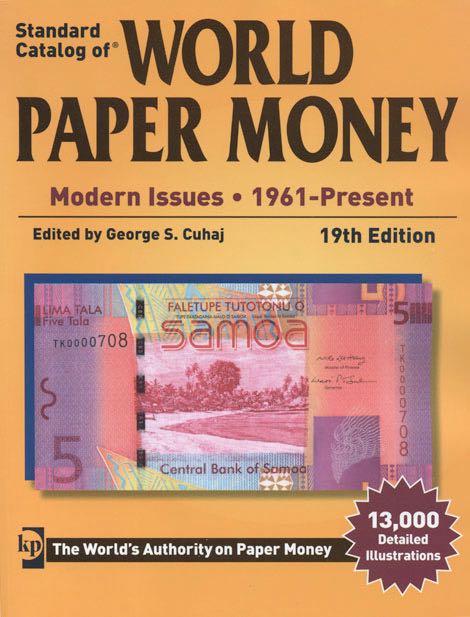
The 19th edition of Krause’s Standard Catalog of World Paper Money carries a list price of $70, but this 1,160-page black-and-white paperback without PDF version on CD-ROM can be ordered from Amazon for only $43.07 with free shipping. Of course, I’d prefer everyone purchase a subscription to my own catalog, The Banknote Book, but if you are going to buy the latest SCWPM, please order from Amazon so that BanknoteNews.com earns a referral fee.
I had planned to write a new review of the 19th edition, but instead recommend you simply read my review of the 18th edition because every general criticism remains valid, and even the specific examples of errors cited in my previous review remain uncorrected.
In a nutshell, hundreds of new notes remain unlisted, some listed notes don't exist as described, values do not reflect the current market, many notes are not illustrated, signature tables necessary for distinguishing varieties are missing, descriptions are terse, and typographical and factual errors abound. Of the new issues actually incorporated into this new volume, major new types are sometimes incorrectly shoehorned into old listings as mere varieties, leading me to believe that Krause has reached the page limit for this volume and is taking shortcuts to avoid adding to the page count.
Press release: The Paper Currency of Tibet
04 10, 2012 13:31
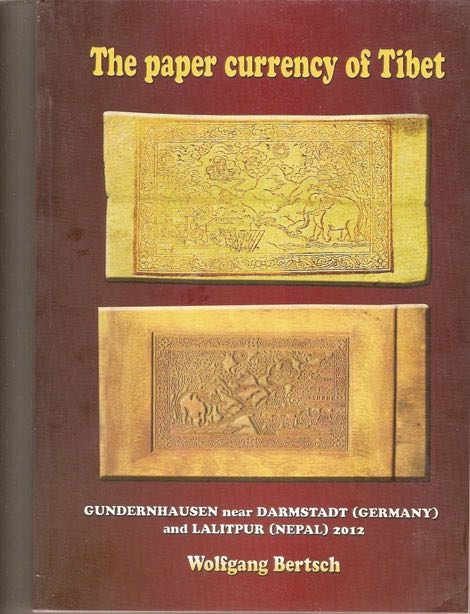
A New Book on Tibetan Paper Money
Wolfgang Bertsch: The Paper Currency of Tibet. Gundernhausen near Darmstadt (Germany) and Lalitpur (Nepal), 2012. VI plus 274 pages. ISBN 978-99933-982-7-1
You can order the book from the author: Wolfgang Bertsch
Tibetan banknotes were issued between 1912/13 and 1959. The first series of “Tam” notes was printed by hand with woodblocks on handmade paper. The multicoloured 50 Tam notes and the following issues in “Srang” were machine printed on native papers. All Tibetan notes were numbered by hand by specially trained calligraphists.
Owing to their artistic design Tibetan banknotes can be considered as part of Tibet’s cultural heritage.
This book explores the historical background which led to their issue, the way in which they were produced and the merit of their artisic design.
The first four chapters of the book are dedicated to the paper notes which were printed and released in Lhasa and include a catalogue part with estimated values of the different issues and their variants. The fifth chapter is dedicated ot semi-official notes issued by an Eastern Tibetan monastery, while the last chapter is dealing with banknotes which bear both Chinese and Tibetan inscriptions and were put into circulation by Chinese authorities in the former province of Xikang which comprised parts of Eastern Tibet and Western Sichuan. Ten apendices provide further information for the specialist and an extensive bibliography concludes the book.
The book is profusely illustrated; all types of the banknotes and many variants and trial prints are reproduced in colour.
With this comprehensive study of Tibetan paper money the author has in mind both the more academically inclined reader who wants to be thouroughly informed about one fascinating aspect of Tibet’s cultural history of the 20th century and the collector of Tibetan banknotes who wishes to identify the pieces in his collection and find out their approximate market value.
CONTENTS
PREFACE
Introduction
CHAPTER I : THE EARLY NOTES IN TAM DENOMINATION
1. The Printing of the the Notes
2. The Ink and the Paper used for the early Banknotes
3. The Seals on the Banknotes in Tam Denomination
4. The 5 Tam Note
4. The 10 Tam Note
6. The 15 Tam Note
7. The 25 Tam Note
8. The blue 50 Tam Note
CHAPTER II
1. The Multicoloured 50 Tam Note
2. A 50 Tam Notes with additional bogus red seals
3. The Project Regarding the Issue of a Multicoloured 25 Tam Note
4. Trial Prints for the planned issue of 25 Tam Notes
CHAPTER III The 100 Srang Note
1. The 100 Tam Srang Note
1 A. The 100 Srang Note
1 B. Forgeries of 100 Srang Notes
CHAPTER IV The 10, 5 and 25 Srang Notes
1. The 10 Srang Note
2. The 5 Srang Note
3. The 25 Srang Note.
CHAPTER V The Paper Notes of Tashi Dargyas Monastery
CHAPTER VI Banknotes from Eastern Tibet (former Province of Xikang)
1. The Banknotes of the Provincial Bank of Xikang
2. Banknotes of the Farmers Bank with Tibetan Overprints
3. Notes of the Central Bank of China with Tibetan Overprints
4. A Note from Gansu Province with Tibetan Legends
Bibliography for Chapter VI
Appendix I: From a letter by W.G. Surkhang to H. Richardson, dated Seattle, July 19, 1966
Appendix II: Copy of a letter by Wesley E. Needham to Joseph J. Woodburn, Jr., dated Westhaven, Conn., April 4, 1951
Appendix III: Transcription of the gist of an Interview by Wolfgang Bertsch with Gelong Lobsang Dhonden on 27th Nov. 1998 at Dharamsala
Appendix IV: Extraxts from a letter by D.N.Tsarong to W. Bertsch
Appendix V: Market Values of Tibetan Banknotes
Appendix VI: The Dates found on Tibetan Banknotes.
Appendix VII: The Scripts used on Tibetan Banknotes
Appendix VIII: Tibetan Banknotes with Four Additional
Seal Imprints
Appendix IX Artist who designed the 100 srang Notes
Appendix X: Tibetan Rare Banknotes in Public and Private Collections and from Published Sources
Bibliography of Tibetan Paper Currency and related Items
Press release: Notes and Coins of the United States of America Federal Reserve System
06 09, 2012 08:21

Publishing and printing complex InterCrim-press is glad to introduce its new book – Notes and Coins of the United States of America Federal Reserve System.
The reference book includes:
- Detailed illustrated descriptions of the US dollars in circulation and their security features;
- Descriptions of coins designated for regular circulation (change) and most popular series of commemorative coins for regular circulation;
- All types of currency notes (treasury notes, gold and silver certificates, national banknotes, World War II temporary currency, etc.) of The US Federal Reserve System since 1928 and until 2012;
- All series of the Federal Reserve Notes (from 1928 to 2009) with the description of their design, security features, and distinctive features of the series: 1928-1934, 1950, 1963, 1969-1988, 1990-1995, 1997-2006, the latest NexGen series;
- Distinctive features in identification design and other security features of US dollar series issued since 1928 until present time. Identification details include the letter denoting a series, the letter and number of Federal Reserve district, the year of issue, control letters of quadrants of printing plate, signatures of Treasurer of the United States and Secretary of the Treasury and other features.
Simple structure of material, pithiness, informative and easy-to-use search system will help you to quickly find necessary and detailed information about any banknote you are interested in.
Now you can order Notes and Coins of the United States of America Federal Reserve System and other InterCrim-Press books online with free delivery at http://www.icpress.ru/en/.
Banknotes of the Ottoman Empire receives IBNS Book of the Year Award for 2012
13 08, 2012 09:20
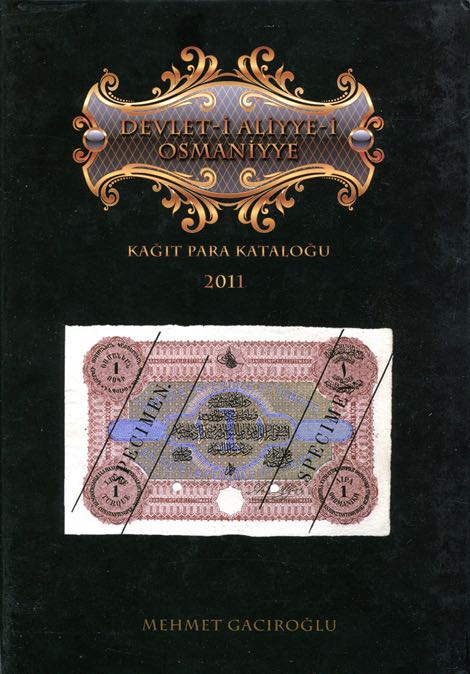
The International Bank Note Society (IBNS) has this year awarded its Book of the Year, for a book published in 2011, to Devlet-I Aliyye-I Osmaniyye (Banknotes of the Ottoman Empire) by Mehmet Gaciroglu. With splendid competition from the ever-increasing works on paper money, the IBNS is pleased to recognize an outstanding accomplishment.
Several reference works on the banknotes of the Ottoman Empire have been written in recent years, but the recently published, award-winning volume by Mehmet Gaciroglu is an impressive contribution to understanding paper money issues in the Ottoman Empire. The distinguished presentation of the book is noteworthy, with its gold title on the dark-coloured cover indicating the quality of the content. Over 340 pages of gloss paper with good quality illustrations, predominantly in colour, continue the impressive presentation.
The merit of the book, however, is in its content. For each denomination identified in the book, descriptions include: the dates of issue, size of the note, the group of issue, signatures, quantity issued, seal used, serial number range and remarks. Where banknotes are illustrated, watermark and signature varieties are adjacent to the banknote; which makes the identification of a banknote very easy for the reader. Values for the notes are given in the grades Fine, VF, XF and UNC, except where the notes are rare and values are sensibly omitted.
A transliteration from Arabic script to modern Turkish script, for both the front and back of the notes, assists readers without the linguistic skills to understand the original text. The Turkish text of the book is complemented with an equal amount of English text, which widens the audience for the book.
Not just a catalogue, the book includes biographies of Sultans and descriptions of the seals used on the notes. Towards the back of the book is a section with colour plates of specimens, essays, artist’s sketches, errors, endorsement stamps and cancellations. Included are the British Gallipoli notes, German legion issues, municipal currencies and local Hebrew, Armenian and Greek issues.
While Banknotes of the Ottoman Empire is deserving of the IBNS Book of the Year, the IBNS gave several Honourable Mentions to other books on paper money published during 2011. These are:
- Billetes de Chile 1879-2011 by Miguel A.Fajardo
- Presidency Banknotes of India (1770-1860) by Kishore Jhunjhunwalla and Rezwan Razack
- New Zealand History Noted – Reserve Bank of New Zealand Bank Notes by Robert Pepping
- Notafilia y Ciencias de la Salud by Jaime Casas PIa (A.N.E.)
- Les Eurobillets – 2002-2011 by Guy Sohier
- English Paper Money – Treasury and Bank of England Notes from 1694 (8th Edition) by Pam West
Press release: InterCrim-Press announced Currencies of the World online directory
10 07, 2012 09:02
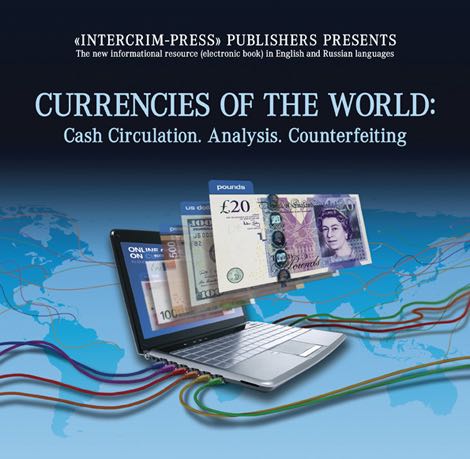
InterCrim-Press is pleased to introduce its new product, “Currencies of the World: Cash Circulation. Analysis. Counterfeiting,” a unique digital resource providing up-to-date information on 182 currencies of more than 250 countries and territories of the world.
The directory is a useful tool for bank employees, security experts of bank financial institutions, law enforcement, customs officials, organizations and businesses of the world currency industry.
The directory consists of three constantly updating modules: "Catalogue of Currencies", "NEWS: Up-to-date information about changes in the currency of the world", and "Counterfeits".
- Module “Catalogue of Currencies" has descriptions of 182 currencies of the world (notes of the main treatment; notes, which are rarely found in circulation, but retained the status of legal tender; notes, which are derived from the circulation: exchanged and canceled; glossary of terms (a full list of terms and concepts with a description of protective elements used in banknote production).
- Module “NEWS” promptly informs about all changes in circulation of the banknotes of the world and provides links to the relevant section of the module "Catalogue of Currencies."
- Module "Counterfeits" contains basic information about counterfeit banknotes, revealed by the law-enforcement agencies in the Russian Federation and CIS countries. Information includes a detailed description of the main signs of counterfeits with the demonstration of fragments (fragments illustrated with simulations of protective elements on the counterfeit banknotes and comparative analysis with similar fragments in genuine banknotes) and of more than 900 varieties of counterfeit banknotes of the following items: rubles of The Bank of Russia, The U.S. dollars, EU euro, GBP of The Bank of England, The Bank of Canada's dollars, francs of The Swiss, People's Bank of China Yuan, the hryvnia of Ukraine, etc.
Each module contains characterization of the protective features of a complex series, high-quality full-color front and back images with the public, and machine-readable security features (images in the UV and IR spectra, magnetic protection), information about the composition of banknote substrate (paper, polymer, composite), printing methods, the date of entry banknotes in circulation, exchange rates.
Try the demo version of the product at http://demo.icpress.ru/en_index.php.
Press release: Monumental Money: People and Places on U.S. Paper Money
05 07, 2012 13:01
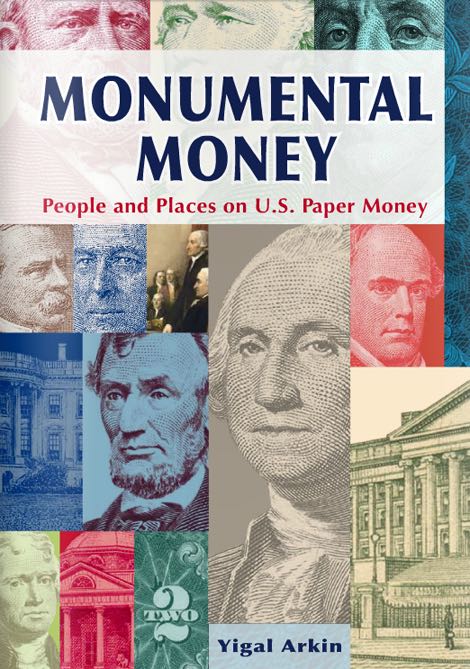
Monumental Money: People and Places on U.S. Paper Money, by Yigal Arkin
Presenting U.S. currency used from the colonial period to the present day, this reference surveys the world of American banknotes and paper currency in three parts:
- Part one presents all the banknotes in circulation today, including those being slowly withdrawn as newer designs replace them, along with color photographs and a brief description of the people and sites depicted on each note.
- Part two provides a brief review of the history of the U.S. monetary system, covering the many different types of banknotes that have been used from the colonial period onward.
- Part three features the high-denomination banknotes no longer in circulation, including the $100,000 note.
History, 112 Pages, 6.5 x 9.5
Four-color Interior
US$17.95 (CAN $19.95)
ISBN: 9780615464541
Arkin Publishing
For details, visit Small Press United from IPG.
New catalog, Banknote Register, covers CIS and Baltic countries
12 06, 2012 17:50

Collectors of banknotes from the countries comprising the former Soviet Union will be interested to know about the Banknote Register, a new 420-page hardcover catalog to be published in August 2012. I have seen samples of this Russian-language catalog and must say I am very impressed. The layout is attractive, with full-color images of notes, watermarks, photos of signatories, and magnifications when needed to illustrate varieties. Although I don't read Russian, the content appears very detailed and comprehensive.
Written by D.N. Zagorenko and edited by S.L. Perkhalsky, the Register provides the most detailed information on all emissions of paper money in post-Soviet countries from 1991 up to present. It describes the history of money circulation establishment and development in the new sovereign states. The book gives detailed information on each banknote, its variations and types, commemorative and souvenir issues, security features, designers and signatories, issuing volumes (lettered series), images portrayed on the notes. It will be no exaggeration to say that the author has compiled the best known up to now data, some of which will be published for the first time, and also data unknown to many collectors. This work has resulted in compilation and classification of the most complete information on currency circulation in the post-Soviet countries.
The publication of the Register will, for sure, reduce the number of blank spaces in the history of circulation in CIS and Baltic states. Nevertheless, the author continues searching for materials and communicating with paper money collectors, designers and bankers. We hope that the Register of Banknotes of CIS and Baltic Countries will encourage you as well to study actively the currency circulation in the post-Soviet countries. The author will go on cooperating actively with collectors, researchers, museum workers, economists, bank specialists and laymen, who are simply keen on the history of currency circulation.
The Register presents state compulsory issues of banknotes of 16 countries (15 independent states – former USSR republics + Trans-Dniester Moldova’s breakaway Republic). The sequence of sections (countries) is based on the listing of republics used in the USSR.
Banknote Register. CIS and Baltic countries.
D.N.Zagorenko, 420 pages (full-colour printing). Hard cover with pressed gilding, wrapper. 210 x 300 mm. Russian, Tirage 3000 pieces. US$55, www.en.reestr-banknot.ru
Book Review: World Paper & Polymer Uncut Banknote
22 05, 2012 14:49
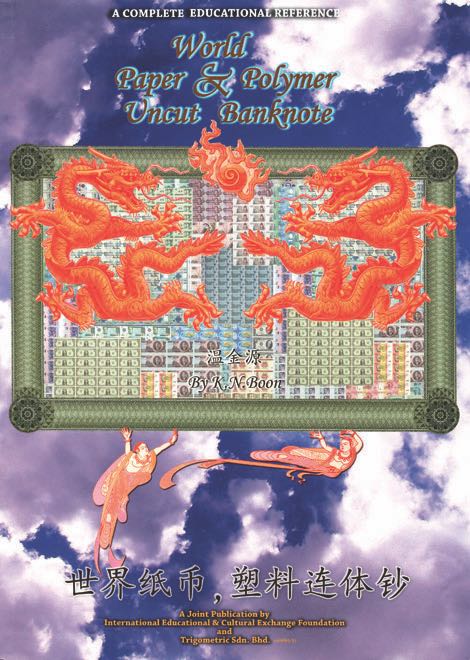
World Paper & Polymer Uncut Banknote
K. N. Boon, 154 pages, soft cover, 297 x 210 mm, color illustrations, Chinese and English, ISBN 978-983-43313-4-4, US$15, www.3833.com
K. N. Boon's recently published book, World Paper & Polymer Uncut Banknote, is the first catalog devoted entirely to collectors of uncut sheets of notes, and as such it fills an interesting gap in the numismatic field of knowledge.
I had hoped to learn more about how and why uncut sheets are sold to collectors, mailing/storage/display options, deciphering plate and block nubmers, etc. Unfortunately, aside from a few pages of introductory text, there's not much prose in this book, the bulk of which is devoted to depictions of the banknote sheets along with brief descriptions and variety listings. The text is written primarily in English, with some material also in Chinese. For the most part, the English is serviceable, in spite of some typos and awkward phrases.
The banknote listings are segregated by substrate, with paper-based notes appearing first, followed by polymer-based notes at the end of the catalog. I would prefer to see all of the notes of a particular country listed together, but collectors who specialize in polymer issues may appreciate having these notes broken out into their own section.
Within the paper and polymer sections, the listings are organized alphabetically by country, then grouped by denominations (smallest to largest), each in chronological order. Unique note types are assigned their own KNB numbers, with lowercase variety letters appended to distinguish between sheets with different attributes. For example, KNB4a may refer to an uncut block of 4 notes, whereas KNB4b refers to a full uncut sheet of 45 notes. Alas, there are no cross-references to other catalog numbers of the underlying notes.
In most cases, blocks (mini-sheets) or full sheets of notes are illustrated, except when the author wasn't able to obtain such images. In those cases, an individual note is shown instead. I actually prefer this latter presentation because the note's design details can be seen, which is not the case when the sheets are reproduced greatly reduced in size. I hope the second edition of this book will include larger illustrations of the front and back of individual notes to each listing for the best of both worlds. Another improvement would be expanded descriptions of the notes. Many notes lack any descriptions at all, and for those that are described, the text is terse and typically applies only to the front; usually the backs are ignored altogether.
Each listing has columns for Date of Issue, Quantity Issued, Issued Price, and Market Price, with the last two values shown in Chinese yuan (RMB). Market prices are given for almost all listings, but in many cases the other columns are left blank. Hopefully further research will result in this information being added in future editions.
Unfortunately, some unscrupulous sellers cut notes from sheets in an attempt to create "errors" or rare prefix varieties which are then foisted upon unsuspecting buyers. To the author's credit, some listings include warnings about this practice, and some listings also indicate the prefixes found on the sheets, but it's unclear if these prefixes are exclusive to sheets. More detailed prefix information might allow for the easy identification of such doctored notes.
World Paper & Polymer Uncut Banknote is an excellent first attempt to systematically document an area of collecting that has heretofore been largely ignored by other catalogs. Collectors of banknote sheets will most definitely appreciate having this handsome, professionally printed, full-color volume in their reference library.
Check out other book reviews and news on the Books page of this site.
Press release: Gibraltar's Currency & Banknotes 1898-2011
19 04, 2012 09:51
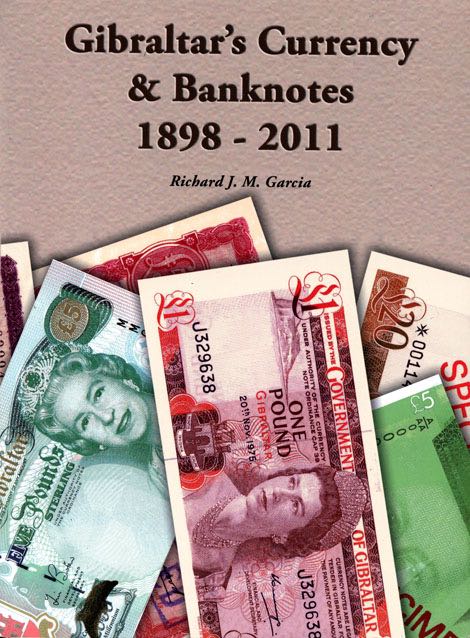
Gibraltar's Currency & Banknotes 1898-2011
by Richard J. M. Garcia, 109 pages, soft cover, 250 x 150 mm, color illustrations, English, ISBN 978-1-919663-09-8, US$24.95 (airmail postage included), braid@gibtelecom.net
Richard Garcia’s latest book addresses a topic that has never hitherto been studied, that of money in Gibraltar from 1898 to 2011. The choice of dates was deliberate. Gibraltar adopted sterling currency as the only legal tender in Gibraltar in 1898. It was in 2011 that the Gibraltar Government assumed sole responsibility for the design, printing and production of banknotes, taking over responsibilities that until then had been the preserve of a Secretary of State in England. A lot happened in between.
The book is not just about banknotes: it sets out to place Gibraltar’s currency in a social history context, looking at how Gibraltar was changing and developing and how these changes were reflected by our banknotes and coinage. It is the fruit of research in the Government Archives and in the Treasury. It explores a number of areas including:
- Why Gibraltar adopted sterling currency in 1898. The accepted reason for this has hitherto been that it was the result of the inflation which accompanied the war of 1898 between Spain and the United States. This was not, in fact, the case.
- Why Gibraltar chose to issue banknotes in 1914, at the time of the outbreak of World War I, and the procedure that was followed in arriving at the design of the banknotes and printing them, without previously having consulted London.
- The financial crisis that arose on the outbreak of the Spanish Civil War in 1936.
- What happened in Gibraltar during World War II in terms of demand for currency notes in the light of the evacuation, the feared invasion of Gibraltar, and the build-up of troops in Gibraltar.
- The impact of the Spanish blockade of the 1960s and the eventual closure by Spain of the land frontier with Gibraltar and the withdrawal of Spanish labour.
- The introduction of decimal currency in 1971.
- The introduction of Gibraltar circulating coins.
- The reasons for the subsequent issue of higher denomination currency notes.
There are 52 colour illustrations in the book. The design of the front and back of every design used for a Gibraltar banknote is depicted, including the rare notes of 1914. There is also a complete listing of all 73 currency notes issued by Gibraltar, indicating the date of issue of the note and the signature on it.
The book is a companion to the article written by Richard Garcia and which was published in the Gibraltar Heritage Trust journal, tracing Gibraltar’s currency from 1704 to 1872, when Spanish currency was adopted as Gibraltar’s only legal tender.
Check out other book reviews and news on the Books page of this site.
Book Review: Coins and Banknotes of Yugoslavia, Slovenia, Croatia, Bosnia and Herzegovina, Serbia, Montenegro and Macedonia
14 03, 2012 20:45

Coins and Banknotes of Yugoslavia, Slovenia, Croatia, Bosnia and Herzegovina, Serbia, Montenegro and Macedonia
Zlatko Viščević, 1173 pages, soft cover, 192 x 120 mm, black and white illustrations, Croatian and English, ISBN 978-953-56890-0-3, US$52 / €40 plus shipping, www.hrvatskanumizmatika.net
Download the free sample chapter: Coins and Banknotes of the Kingdom of Yugoslavia.
Reviewed by Owen W. Linzmayer 7962
As author Zlatko Viščević mentions in the introduction to his impressive new catalog, collecting banknotes from the area of the former Yugoslavia can be quite challenging due to the large number of notes issued over the years. Compounding the problem is the Serbo-Croatian text on these notes and the complicated history of the region, both of which may be unfamiliar to many collectors. This new catalog doesn’t attempt to explain the tumultuous politics of the past three centuries, but is an invaluable addition to the reference library of anyone who specializes in collecting notes from this part of the world.
The first edition of this catalog was published in 2007. The second edition covers regular and commemorative notes issued in the intervening years, goes into greater depth in the descriptions, and now also includes special, fantasy, and private issues. In short, if you already own the first edition and like it, you’ll definitely want to buy the much-improved and expanded second edition.
Coins and Banknotes’ title spells out exactly what’s inside. The first half of the book is devoted to coins, the second half to notes, with chapters for the seven countries in each section. Within the chapters, the coins and notes are listed chronologically by denomination, which makes it easy to locate a particular piece and track changes over time, but at the expense of presenting complete families with common or complementary designs.
Each note type listing contains the denomination, catalog number, cross-references to Pick numbers and other specialized catalogs, reduced-size illustrations of the front and back, description of design elements and security features, and finally a list of varieties, with checkboxes for tracking your collection. Each variety is assigned a six-level rarity rating, and has values in euros for up to four levels of condition. Some notes also have auction results at the bottom of the page, though the values and results don’t always agree. Occasionally there are inset illustrations of details which determine varieties. These are useful in most cases, but sometimes the differences aren’t obvious due to the small size or lack of color in their reproduction.
Specialized collectors will appreciate the comprehensive lists of prefixes, as well as the inclusion of specimen and replacement notes in the variety tables, not to mention the assortment of “irregular issues” (color trials, partial proofs, etc.) and private/fantasy notes covered separately. While there isn’t much explanatory text regarding these issues, anyone interested in pursuing further research can consult the bibliography of source books and web sites at the end of each chapter.
The longer passages of prose in the catalog are presented in both Croatian and English, but the descriptions of the notes and their varieties are in Croatian only, which is a little frustrating if you care about such details and don’t want to rely upon Google Translate. Fortunately the English text everywhere else in the book is good enough that it’s easy to overlook the minor typos and understand the gist of the intended meaning.
One complaint I have about the catalog is its size. This is a bulky, compact tome measuring a whopping 55 millimeters thick, and heavy enough to break a toe if dropped on a foot. I would have preferred the coin and banknote sections split into two separate volumes, both printed in a larger format. As it is, the small black and white illustrations don’t do justice to the beauty of the notes, and the tiny text is hard to read if your eyesight isn’t perfect.
With this second edition, Zlatko Viščević has created a solid reference for collectors of notes of Yugoslavia and its constituent republics from 1849 to 2011. Coins and Banknotes delivers a dense helping of numismatic information at price that can’t be beat.
18th edition of Standard Catalog of World Paper Money now available
19 02, 2012 15:00
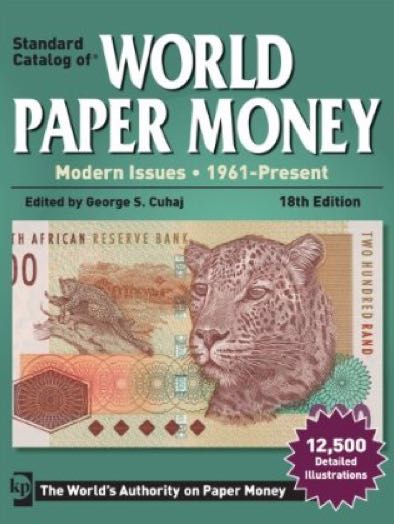
The 18th edition of Krause’s Standard Catalog of World Paper Money carries a list price of $70, but this 1,160-page black-and-white paperback without PDF version on CD-ROM can be ordered from Amazon for only $44.10 with free shipping. Of course, I’d prefer everyone purchase a subscription to my own catalog, The Banknote Book, but if you are inclined to buy the latest SCWPM, please support BanknoteNews.com by ordering from Amazon.
Simply put, the 18th edition of the SCWPM is another dog’s breakfast from Krause; a few nuggests of new material mixed into a warmed-over mess of dubious content from past editions. While there are a few entries for notes dated as recently as 2011, the updates are uneven. Qatar and United Arab Emirates, just to name a few, are missing new note types which were issued four years ago. There are literally hundreds of new note types and varieties issued over the past few years which haven’t made it into this new edition (The Banknote Update contains 70 pages of images and info missing from the 18th edition of the SCWPM). Of those that have been added, very few are illustrated, and the descriptions of same are extremely bare bones, often containing erroneous information, such as incorrect dates.
The many mistakes I uncovered on a cursory examination of the new catalog leads me to believe that Krause doesn’t bother verifying information submitted by contributors, and almost certainly hasn’t compiled high-resolution images of notes to double-check details such as dates, signatures, and security features. How else can you explain listing substantially revised note types as varieties of older issues? For example, several of Nigeria's current polymer issues are listed as mere date and signature varieties of paper notes.
Krause continues to employ the practice of assigning Pick numbers to “expected new issues” which history has proven often aren’t forthcoming and leads to vestigal listings in the catalog that take years to remove, if ever. Case in point, Nigeria's Pick 31, a non-existant 2-naira note dated 2006, which has been wrongly included in the catalog since the 15th edition. It's joined this year by South Sudan’s 50-piaster note, listed as Pick 4, even though this denomination was never issued after being dropped in favor of a coin. Given its poor track record of cleaning up its past mistakes, Krause should adopt the simple rule, “When in doubt, leave it out.” Much better to be incomplete or a bit late than to be flat-out wrong.
Don’t get me started on the values for the other denominations from South Sudan, none of which reflects true market values, and most of which are far below face values. On the flip side there are many countries where notes are valued at large multiples of the current going rate. Don't believe me? Search for "CV" (catalog value) in eBay listings. You'll find thousands of listings where the sellers are tacitly advertising that the SCWPM valuations are grossly inflated.
The only people who should consider buying the 18th edition are banknote dealers, because like it or not, currently Pick numbers are the most common shorthand method used to track inventories. If you need to know the Pick number/letter which has been assigned to a new note, the SCWPM is the only game in town. But if you're a collector who cares about having an up-to-date catalog with beautiful notes rendered in full color, accurate valuations, complete signature tables, detailed descriptions, and so much more, I humbly suggest you try The Banknote Book instead.
IBNS Book of the Year: Standard Catalogue of the Provincial Banknotes of England and Wales
18 06, 2011 09:31

The International Bank Note Society (IBNS) has awarded its 2011 Book of the Year, for a book published in 2010, to The Standard Catalogue of the Provincial Banknotes of England & Wales by Roger Outing. The announcement was made at the Annual General Meeting of the IBNS in Memphis, Tennessee, USA in early June.
Already considered an essential guide for collectors of English and Welsh paper money, Roger Outing’s book covers a wide range of bank note and banking information. While the book carries on the pioneering work of Geoffrey Grant’s The Standard Catalogue of Provincial Banks and Banknotes, there is much more to Mr. Outing’s work. The main section of the new work is an alphabetical listing of issuing banks by town, which also incorporates the multi-branch joint stock banks. This is followed by a full listing of the London private and joint-stock banks; most of which never issued banknotes, but the comprehensive coverage is a boon for bank historians, as well as collectors of cheques and other financial ephemera. A further section lists all non-bank issuers by town of origin – mostly collieries, ironworks and the like, which issued notes in the early years of the nineteenth century. The final section covers Skit Notes, an area not previously researched in detail. Skit Notes were often prepared for advertising, entertainment or political purposes, and quite often were designed to look similar to genuine notes. While only items issued prior to 1900 are included, there are still details of some 63 ‘issues’.
The Standard Catalogue of the Provincial Banknotes of England & Wales is an impressive work – not only is the information of great value, it is very well presented. A large format, hard-back publication of 520 pages, with over 850 colour illustrations, the book has been prepared to a high standard by its publishers – Token Publishing of the United Kingdom. This catalogue and price guide is a wonderful example of the investment of time and effort into the research of paper money and the IBNS congratulates Roger Outing on a valuable achievement and contribution to the world of paper money.
Book review: Moneymakers
12 06, 2011 17:09

Moneymakers: The Wicked Lives and Surprising Adventures of Three Notorious Counterfeiters by Ben Rarnoff (Order from Amazon.com)
This 396-page hardcover was a bit of a disappointment for me, perhaps because I am very interested in the subject of counterfeiting from a technical perspective and this book focuses more on the forgers themselves and the economic state of America during the times in which three “most successful counterfeiters” operated, starting in Colonial times, then the early 1800s, and finally during the Civil War. Also, I found the attempts to draw parallels to the recent Wall Street scandals a bit of stretch, as was the author’s portrayal of these criminals as Robin Hood figures merely helping out the ordinary citizens by producing money the banks couldn’t or wouldn’t supply in sufficient quantities to meet popular demand.
Check out other book reviews and news on the Books page of this site.
6th edition of Standard Catalogue of World Plastic Money now available
12 06, 2011 15:53
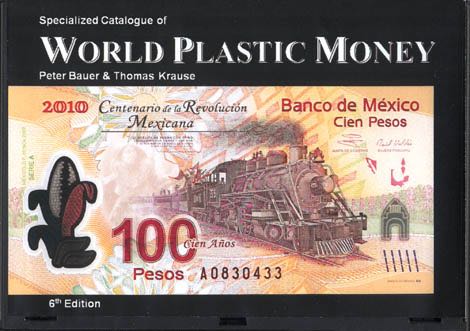
Anyone interested in the increasingly popular field of polymer banknote collecting should definitely purchase a copy of the Specialized Catalogue of World Plastic Money, written and compiled by Peter Bauer and Thomas Krause, the expert behind the Polymernotes of the World web site and a frequent contributor to BanknoteNews.com. The 6th edition was published in April 2011 and costs only 20 euros plus S&H for the disc which contains an installer for the PDF-based 406-page catalog.
Krause publishes SCWPM: General Issues Volume II, 13th Edition
05 10, 2010 17:13
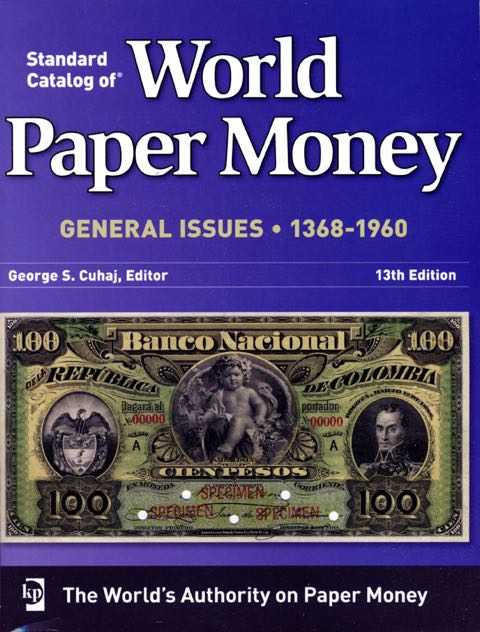
Krause Publications has released a new 13th edition of the Standard Catalog of World Paper Money, General Issues, 1368-1960. I haven’t gotten a copy yet, but according to the press release, key features of the book include:
• 25,100 bank note varieties with current values in three condition grades.
• Enhanced note and color descriptions, allowing users to quickly identify varieties.
• More than 8,000 quality photographs to assist with identification.
• Historical details, grading definitions and numeral charts.
Like it or not, the SCWPM remains "the bible" for our hobby because its Pick numbers are almost universally used to identify notes. If you intend to get a copy despite its flaws, please support this site by buying the latest edition using this link.
Check out other book reviews and news on the Books page of this site.
Book review: Apples Are From Kazakhstan
05 10, 2010 07:59
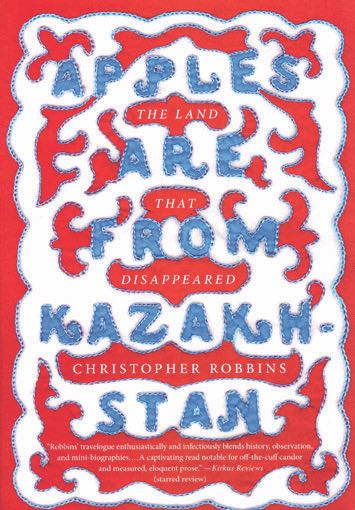
Apples Are From Kazakhstan:: The Land that Disappeared by Christopher Robbins (Order from Amazon.com)
This 296-page paperback book is a fascinating look at a country most Westerners barely know. The English author Robbins does a wonderful job of weaving his personal experiences in this former Soviet republic with rich historical background, from ancient times to repression under Russian rule in the last century. Of particular interest to banknote collectors is the chapter in which Robbins recounts the secret—and ultimately successful—plan to introduce tenge banknotes in 1993 to avoid being at the mercy of Moscow when it replaced the Soviet ruble with the new Russian ruble.
Check out other book reviews and news on the Books page of this site.
Book Review: World Paper Money Errors
20 07, 2010 11:07
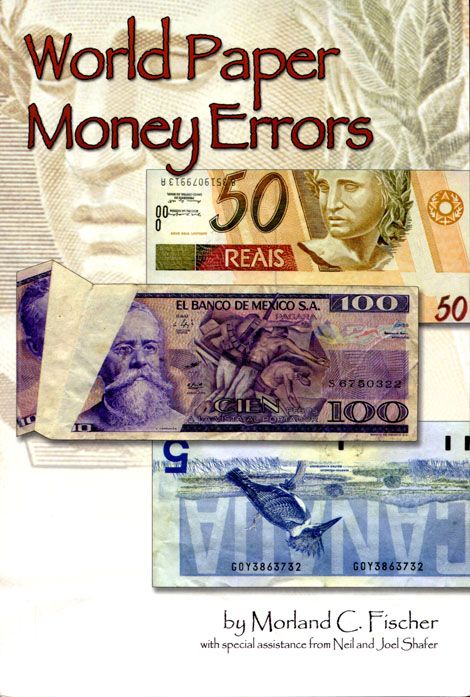
World Paper Money Errors by Morland C. Fischer (Order from Amazon.com)
250 pages, soft cover, 230 x 150 mm, color illustrations, English, published by Zyrus Press Publishing, ISBN 978-1-933990-25-5
Reviewed by Owen W. Linzmayer
While there are several catalogs covering United States paper money errors, this book is the first attempt at a systematic approach to describing, documenting, and pricing errors on world banknotes. As such, it’s an important new addition to the world’s numismatics knowledge base, but it suffers from some shortcomings I hope will be addressed in future editions.
Author Morland C. Fischer does a very good job of explaining the various types of errors found on banknotes and has distilled them down to an eight-point FEN (Foreign Error Note) ranking system in which higher numbers correspond to more significant errors. Reasonable people might disagree over whether a missing overprint is more dramatic an error than an inverted back (FEN 4 and 7, respectively), but the codification of the taxonomy of errors is a welcome improvement to a subjective field of study.
The bulk of the book is devoted to illustrating the various error types, each broken into their own chapters. I found the introductory explanations of how specific types of errors happen in the production process particularly interesting. The book has color illustrations throughout, usually with the front and back of the error note at 50% actual size, along with a non-error note for comparison. This allows you to see the magnitude of the error and appreciate the artwork and intended design of the reference note, although some illustrations would have benefited by close-ups or annotations to highlight the affected areas of the note. There are lots of examples from many different countries and time periods, which is good overall, but it’s overkill for some types of errors, such as missing serial numbers, which are easy to understand without repetitive illustrations.
Personally, I would have liked to see more plate errors—also known as engraving errors—because I find man-made errors more intriguing than machine mistakes. As a writer and editor myself, I’m amused by the fact that central banks sometimes fail to catch embarrassing typos until after printing and issuing millions of notes into circulation. Alas, there are only a dozen such errors discussed. Entirely lacking are any examples of errors in security features, such as when a thread intended for one note appears in another, or the wrong watermark is used.
Anyone who has contemplated buying an error note will do well to first read the chapter on “pseudo” errors. At first glance these appear to be errors, but may have been intentionally created by unscrupulous collectors/dealers by miscutting individual notes from sheets or using chemicals to alter notes, for example. Sometimes they aren’t errors at all, but rather printers’ waste, proof notes, or remainders. Buyer beware.
Ironically, the author is not immune to making errors of his own. For example, he mistakes the front and back of Ukraine’s 20-hryvan note of 1992 (Pick 107), includes a 1,000-shilling fantasy note from Somaliland without mentioning its dubious origin, and the last few pages of the book are incorrectly set in fonts of varying size, resulting in a jumbled appearance. However these are all minor quibbles; for the most part the content is solid and unassailable.
My main complaint with this book is that author tries too hard to make the case that world error notes are undervalued. He provides a number of possible explanations for the disparity in prices between comparable errors on US and foreign notes, yet ignores what might be the most obvious explanation of all: differences in the values of the corresponding non-error notes. For example, he laments that a foldover error on a United States 10-dollar note dated 1969C (Pick 451d) is worth $1,000 - 2,000 whereas a similar printing error on a Mexican 500-peso note (Pick 69) is valued at $200 - 300. But when you consider that the SCWPM lists non-error examples of the former at four times the value of the latter, the price disparity between the errors doesn’t seem so significant nor unwarranted.
Judging by the passion with which he approaches his subject, it is apparent that the author loves error notes, but his insistence that world error notes are “undervalued,” with “considerable upside potential,” and “could be ready to explode,” comes across as a hard sell by someone with an agenda. I found cause for pause when reading “In some instances, a price may appear to be unusually high. However, prices were chosen to indicate what should be [emphasis mine] the fair market value…Moreover, the assigned price ranges reflect an extrapolation of expected prices over a period of five years from publication.” Pricing non-error world notes is fraught with difficulties (fluctuations in currency exchange rates and differences in foreign/domestic demand for a country’s own notes, for example) which are only compounded when considering far less common—sometimes even unique—error notes and trying to guess what they should be worth far into the future. The book would have greater credibility if it merely reported current free market prices and suggested reasonable premiums a collector might expect to pay for different types of errors.
World Paper Money Errors carries a list price of US$34.95 and can be ordered directly from Zyrus Press Publishing, P.O. Box 17810, Irvine, CA 92623. (888) 622-7823. www.zyruspress.com or purchased from Amazon at a significant discount.
New edition of Standard Catalog of World Paper Money now shipping
25 05, 2010 19:38

The 16th edition of Krause’s Standard Catalog of World Paper Money is now shipping. I just received my copy and wanted to share my initial impressions.
At 1,112 black and white pages, it's exactly as large as the previous edition, though its list price is now $60 instead of $55, and it does not come with a disc containing a PDF version of the catalog, which is a great disappointment.
Also somewhat disappointing is that values for VG conditions have been eliminated. Now only VF and UNC conditions are listed. While some will decry this change, I think it’s a reasonable change because most modern notes collectors insist on UNC anyway.
More troublesome is that this edition continues the trend of covering only a fraction of the new note types and varieties that have been issued in the past years, and illustrating almost none of them. It appears that the cut-off for inclusion in this catalog was mid-2009, but many, many notes issued well before then failed to make it into print (The Banknote Update contains over 80 pages of images and info missing from the 16th edition of the SCWPM).
In an attempt to appear more current than it really is, the catalog has assigned Pick numbers to a lot of "expected issues." The problem with this practice is that many such notes are never released, inevitably forcing the editors to renumber at a future date, much to the frustration of collectors and dealers everywhere (my cursory examination uncovered a half dozen notes that have been renumbered or deleted between editions). Furthermore, the information (such as dates) in the listings for these expected issues often proves wrong, adding to the general confusion.
Speaking of frustrating and confusing, some listings refer to non-existent signature charts, or the signature chart exists, but hasn’t been updated to include the latest signatures, making it impossible to distinguish between varieties.
I haven't done a thorough check of the entire catalog, but a spot check revealed some obvious pricing problems, such as listing Armenia's 100,000-dram note at $250 in UNC, even though its face value is $263. The 50,000-won from South Korea, featured on the cover of the new edition, is worth $40 at face, but is listed at $50 in UNC. Good luck finding dealers selling notes with negative or nominal mark-ups.
Like it or not, the SCWPM remains "the bible" for our hobby because its Pick numbers are almost universally used to identify notes. If you intend to get a copy despite its flaws, please support this site by buying the latest edition using this link.
History of Paper Currency in the Seychelles available
09 05, 2009 11:43
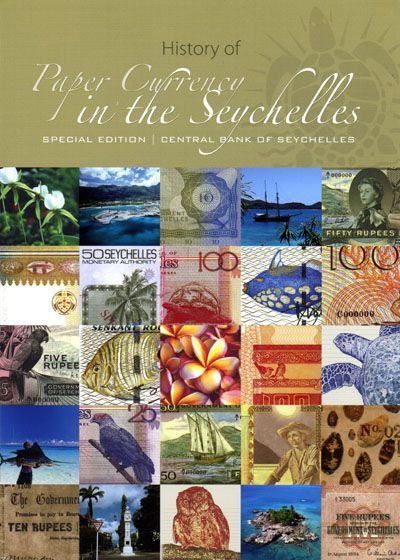
On December 2008, the Central Bank of Seychelles published a special second edition of its publication that traces the history of paper currencies in the Seychelles, dating from the period of French colonization to the present.
Entitled “History of Paper Currency in the Seychelles,” the new 55-page booklet, in full colour, should prove useful not only to banknote collectors but also for educational purposes, as it includes a section which describes the flora & fauna appearing on the most recent paper currencies of the islands.
Divided into sections pertaining to marked periods and events in the life of the Seychelles currency, the booklet provides colourful illustrations of the different forms of paper currency used over the years.
Information for the booklet was compiled by a small group from the Central Bank with the help of the National Archives and several individuals who are experts in their fields. They include Adrian Skerrett (conservationist), Dr. Jeanne Mortimer (biologist and conservationist), Julien Durup (archivist and historian), Kantilal Jivan Shah (historian, naturalist, conservationist, artist, photographer, healer, numismatist and philatelist) and Stella Doway (Senior Museum Curator).
In a foreword to the publication, CBS Governor Francis Chang Leng says: “It is a rewarding feat for readers to explore the different varieties, sizes and designs of the various denominations of the Seychelles rupee notes, which have been issued over the years, not forgetting the individuals who were in authority in the country at the time the notes were printed and issued. Not only is this booklet very informative, but it can also be used as a guide for currency enthusiasts.”
The Central Bank of Seychelles sells copies of this book from its web site, but isn’t very responsive to email inquiries, and only accepts wire transfers which are costly and time-consuming. After jumping through a lot of hoops, I was finally able to obtain a few copies of this amazing book, but these have now been spoken for. Good luck to anyone attempting to purchase directly from the CBS. By the way, the CBS web site still shows the first edition of this book, but I believe that has sold out and that only the second edition is currently available.
Banknotes of Bhutan catalog published
29 04, 2009 21:39
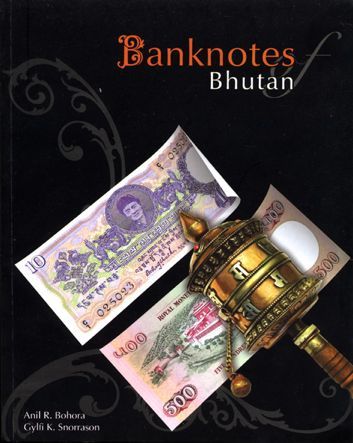
Anil R. Bohora and Gylfi K. Snorrason have just published a new catalog called Banknotes of Bhutan (ISBN 978-81-7525-881-5). This 137-page softcover book is beautifully illustrated in full color throughout, with large front and back images of all notes, and details of vignettes that are thoroughly explained. The book contains everything there is to know about the kings, monuments, and auspicious symbols that appear on Bhutanese notes, as well as the signatories, watermarks, and printers.
I highly recommend Banknotes of Bhutan to anyone interested in this Asian country’s numismatic history. The book costs US$25 + $6 S&H and can be purchased by emailing enterandbuy@yahoo.com.
5th edition of World Plastic Money catalog published
20 12, 2008 07:02

Thomas Krause and Peter Bauer have today released the fifth edition of their book, the Specialized Catalogue of World Plastic Money. Ordering information and a free PDF download can be obtained by visiting www.swschwedt.de/kunden/polymernotes.
Bank of Israel publishes new book on notes and coins
11 10, 2006 10:47
The Bank of Israel has published a new book, “Banknotes and Coins of Israel 1927-2006.” The fruit of intensive research, the book is published by the Currency Department of the Bank of Israel.
The book details the entire series of banknotes and coins issued during the period covered. Each note and coin is presented pictorially, and accompanying text describes both the design of motif and the choice behind it. The publication is unique in its technical detail of the notes and coins––size, cover, security measures against counterfeiting, designers and periods of circulation––as well additional background material including the original photographs which provided the source of the designs of the banknotes and coins. Next to the photos of each coin is an example of the original coin––usually an ancient Hebrew coin––upon which the modern coin was based.
The book has a foreword by the Governor of the Bank, Professor Stanley Fischer, and was written by Yigal Arkin, a collector and researcher of means of payments, with scientific editing by Dr. Rachel Barkay, numismatic curator of the Bank of Israel.
This colorful, hardback, richly illustrated book has colored margins for ease of reference. The Bank of Israel hopes that such an extensive compendium will provide both a source of information and enjoyment to the public, and will help to increase general knowledge of the banknotes and coins of both the modern-day Israel and of the young state-in-the-making.
The book is available in both Hebrew and English and is priced at NIS 98 (approximately US$23).
Though the book will shortly be for sale at stores, currently it can only be purchased directly from the Bank of Israel. To buy the book, payment can be either by credit card from the Publications Unit of the Bank of Israel: Tel: 02-6552767; Fax: 02-6552984; email: matikahn@boi.gov.il; or by sending a check (payable to the Bank of Israel) to: The Bank of Israel Publications Unit P.B. 780 Jerusalem 91007.
The book details the entire series of banknotes and coins issued during the period covered. Each note and coin is presented pictorially, and accompanying text describes both the design of motif and the choice behind it. The publication is unique in its technical detail of the notes and coins––size, cover, security measures against counterfeiting, designers and periods of circulation––as well additional background material including the original photographs which provided the source of the designs of the banknotes and coins. Next to the photos of each coin is an example of the original coin––usually an ancient Hebrew coin––upon which the modern coin was based.
The book has a foreword by the Governor of the Bank, Professor Stanley Fischer, and was written by Yigal Arkin, a collector and researcher of means of payments, with scientific editing by Dr. Rachel Barkay, numismatic curator of the Bank of Israel.
This colorful, hardback, richly illustrated book has colored margins for ease of reference. The Bank of Israel hopes that such an extensive compendium will provide both a source of information and enjoyment to the public, and will help to increase general knowledge of the banknotes and coins of both the modern-day Israel and of the young state-in-the-making.
The book is available in both Hebrew and English and is priced at NIS 98 (approximately US$23).
Though the book will shortly be for sale at stores, currently it can only be purchased directly from the Bank of Israel. To buy the book, payment can be either by credit card from the Publications Unit of the Bank of Israel: Tel: 02-6552767; Fax: 02-6552984; email: matikahn@boi.gov.il; or by sending a check (payable to the Bank of Israel) to: The Bank of Israel Publications Unit P.B. 780 Jerusalem 91007.
